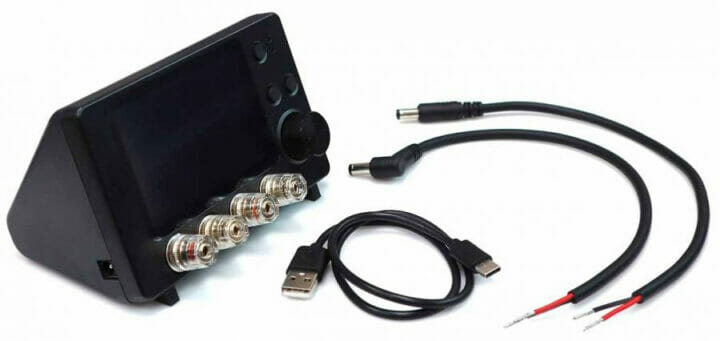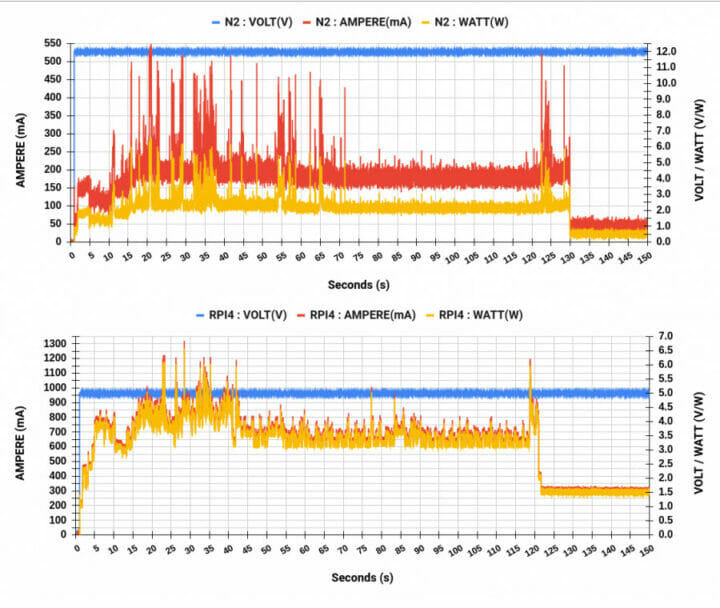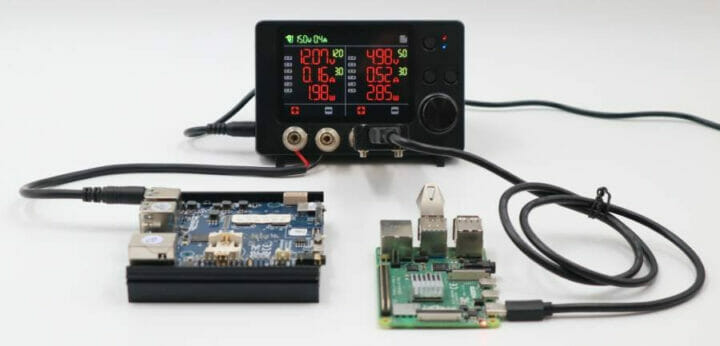Hardkernel has launched a number of popular Arm SBC’s with the ODROID family over the years, but the Smart Power 3 is a different type of product, as the ESP32-based smart power meter can help embedded systems engineers optimize their hardware and software power consumption and/or check for spurious power peaks during boot up or shutdowns.
In the past, we’ve reviewed relatively expansive tools like Qoitech Otii Arc or gone the DIY route, but at $45, Hardkernel offers a power monitoring solution that’s both inexpensive and easy to use, albeit with fewer features than Qoitech’s device.
- MCU – ESP32 dual-core microcontroller via ESP32-WROOM-32E module
- Output Channels – 2x output channels (Max 50W + 50W) via 2x 4mm banana jacks each
- Output Voltage – 3V DC to input voltage – 1V
- Output Current – 3A max per channel
- Measurement
- Voltage, Current, Power
- Maximum sampling rate: 200Hz (5msec interval)
- Display – 3.5-inch TFT IPS LCD wide viewing angle, 480×320 resolution
- Host interface – USB Type-C port for connection to PC for data communication and firmware upgrade
- Misc
- Red power LED, Blue “Alive” (Active?) LED
- Buttons – ON/OFF/Menu/Cancel, Output Channel On/Off
- Rotary encoder for voltage and current adjustment, also work as Select/Setup button
- Input Voltage – 9V to 21V DC

 The device ships with a USB-C data cable, and two DC plug cables (5.5/2.1mm) compatible with ODROID-XU4, ODROID-N2, and ODROID-C4. You’ll also need a power supply, and Hardkernel offers an optional 15V/4A PSU that sells for $9.4. A 19V laptop power brick should also work, so in theory, you would not necessarily have to buy an extra power supply.
The device ships with a USB-C data cable, and two DC plug cables (5.5/2.1mm) compatible with ODROID-XU4, ODROID-N2, and ODROID-C4. You’ll also need a power supply, and Hardkernel offers an optional 15V/4A PSU that sells for $9.4. A 19V laptop power brick should also work, so in theory, you would not necessarily have to buy an extra power supply.
The data is shown in real-time on the display, but the Smart Power 3 is mostly useful thanks to its ability to send data to a host computer. Despite ESP32 supporting WiFi connectivity, the tool only sends data over USB to a serial interface at 921,000 bps (by default). There’s no fancy software to handle the data, and instead, comma-separated values are sent to a serial console program like “GNU Screen”.
 The data received in the terminal can then be saved into a CSV file before being imported into your preferred spreadsheet program for charting and analysis.
The data received in the terminal can then be saved into a CSV file before being imported into your preferred spreadsheet program for charting and analysis.

It can also be used for eventual voltage drops, and software/hardware could be optimized for applications that eventually aim to run on battery. Although it’s possible to look at the values in real-time in the serial console, the lack of real-time charting is not ideal, so maybe it could be integrated with an open-source solution such as Sigrok/Pulseview or RPI-Monitor if one use an SBC has the host computer.
Implementing data acquisition over WiFi might be interesting too, both for convenience and possibly higher sampling rates (if possible based on the rest of the hardware). The ESP32 firmware used in Smart Power 3 is open-source, so it could also be improved upon. You’ll find more documentation and the firmware source code in the Wiki.
Smart Power 3 tool can be purchased directly for $45 on Hardkernel’s website, and may show up on distributors soon as well. Somehow the power supply is not optional, and at this time, you’d have to add a 15V/4A ($9.4) or a 19V/7A ($25) power adapter to complete your order.

Jean-Luc started CNX Software in 2010 as a part-time endeavor, before quitting his job as a software engineering manager, and starting to write daily news, and reviews full time later in 2011.
Support CNX Software! Donate via cryptocurrencies, become a Patron on Patreon, or purchase goods on Amazon or Aliexpress





